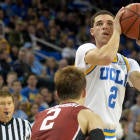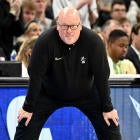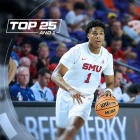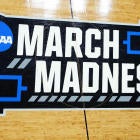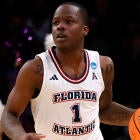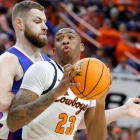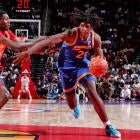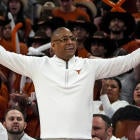Lonzo Ball has captured college basketball's attention not just because he's as dynamic a freshman as we have in college hoops, but because his shooting form looks like he's trying to wobble a small reptile off his right arm.
It's been enrapturing to watch Ball become such an all-around force while he swipes convention in the face, raining NBA-distance 3s with the most peculiar shooting motion I've ever seen. But it's hard to argue with the results. Clipping 44 percent on 116 attempts from 3 -- many of them from beyond 25 feet and against legitimate competition -- brings no lies. Ball's shooting stroke is not orthodox, but the most important aspect for right now, for his play at the college level, is that it's natural.
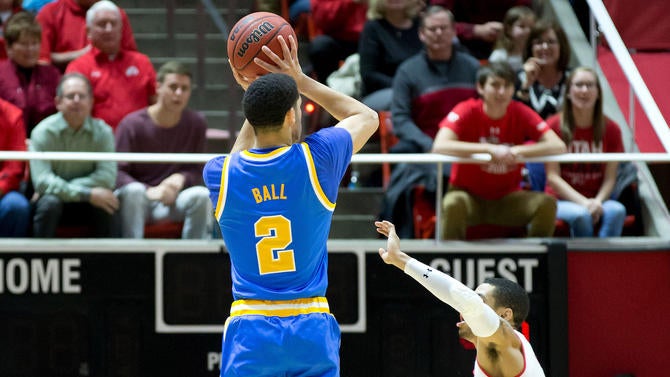
Ball has helped UCLA to a renaissance this season, getting the Bruins to 19-2 while averaging 14.9 points, 8.2 assists 5.6 rebounds and 1.9 steals. He's also extremely efficient, making 69 percent of his 2-pointers, 44 percent of 3-pointers and averaging 1.112 points per attempt, which is among the best by any guard in college basketball.
Yet his method of motion goes against well-established norms of what a good shooting stroke should look like, and so his play carries with it questions of concern, along with general wonder. Ball just looks different from everyone else in college basketball. If you're a serious basketball prospect, these mechanical kinks are supposed to be eradicated by the time you're playing varsity.
Yet here's this tantalizing player with funky form and endless conviction in his range. (It runs in the family.) Look at this GIF below, courtesy of @BigTenGeeks. Ball's feet facing 35-or-so degrees from the rim, he barely gets a hop off the floor, and that release point is as bent as any player I can remember. Unconventional is an understatement. But it works! It's so ugly that it's beautiful.
Lonzo Ball really does have the best looking ugly shot in basketball. pic.twitter.com/RFzmehshKh
— Big Ten Geeks (@bigtengeeks) December 17, 2016
The shot is not short on confidence, and that is an important part of all of this. Ball doesn't have a fast release, but still it is almost never blocked. That's helped to a small degree by the fact that he's prone to pop shots from so far out. Even then, his ball rotation looks good. Scouts like his pre-shot footwork and consistency with his base; when he shoots, he looks the same almost every time. But although he's had success, I think he's going to have a mini reckoning with this form eventually. NBA folks might want to have him deconstruct the shot and have him overhaul the process in an effort to have him ready to shoot off the catch, get a higher release, a cleaner frame and a smoother release.
That could be risky, though. If it's broke, why fix it?
You've probably heard the Ball/Jason Kidd comparisons. But check this out.
Lonzo Ball's jump shot is so Kevin Martin-esque pic.twitter.com/zgWBI6XAhI
— Eric Fawcett (@Efawcett7) January 21, 2017
That's Kevin Martin, who emerged out of obscurity in 2004 after three dominant years at Western Carolina. He played almost a dozen seasons in the league, seven of them wherein he averaged at least 20 points. He was a career 38-percent 3-point shooter. Martin's from looks like a blood relative to Ball's, and he wasn't worse for it. Some guys thrive because they're most comfortable with the least-comfortable form. Martin and Ball have similar builds but play different positions. Martin's a wing, through and through. Ball is a pass-first, new-age point guard.
Ball's shooting is just the bonus -- and it's what's going to make him hard to pass on if you have a top-five pick in June.
What's tricky is how Ball is inhibited from pulling up he goes right. The shot originates on his left side, with Ball pulling the basketball up from his waist and unintentionally fighting natural shooting motion. This makes use of him at the next level problematic in coming off screens, getting the ball high against all-world defenders, and using creativity with the dribble to bring the ball up without having it swiped away. In moving his body from left to right, Ball will either have to change how he builds his shooting form or deal with the consequences.
Get a closer look at Ball's form here. This is only practice shots, but it's as consistent a look at his form as you'll see in one continuous reel.
UCLA coach Steve Alford has an accurate line to close out that video: "When it is of great need to make a shot, he knows how to make a shot."
That's definitely true, and per Synergy Sports information, UCLA's been helped a lot by Ball's ability to score as a spot-up shooter. The Bruins are among the fastest teams in college basketball, so the majority of Ball's points have come in transition, but the second-most frequent option is spot-up, where Ball averages 1.23 points per attempt. In screen situations, he's averaging 1.2 points per attempt. And in rare one-on-one isolation opportunities (per Synergy, Ball has gotten 15 possessions like this), he's at a remarkable 1.467 points per attempt.
He's a great catch-and-shoot player, and can seamlessly accept a shot off screens, and especially right "off the catch," to use coach parlance. The trouble for him could be how the floor is tilted against him. If he can only be used in one direction on screen situations, it alters what an offense wants to do -- or can do -- especially with him playing point guard.
But this hasn't hindered UCLA yet. The Bruins' losses have not come at the expense of their best player's eccentric style. We know he isn't changing it any time soon, and in a way, I hope he never does. If Ball can be at his best when he's most comfortable, that's the best outcome for him and whatever team opts to draft him. Changing him comes with a risk of fixing what might not have ever been broken in the first place.













